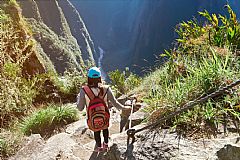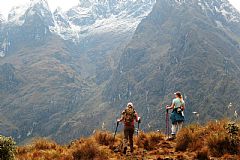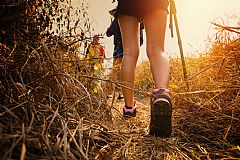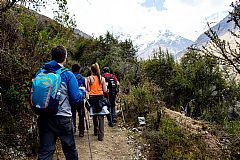Chile, with its stunning landscapes, offers some of the most spectacular trekking destinations in the world. However, to fully enjoy this adventure, you must travel with the necessary equipment.
If you're a trekking enthusiast, you're going to love Chile. A country that seems to have been designed by nature for hiking, with destinations and treasures visible to those fortunate enough to explore its dream-like trekking routes, especially the trails of the majestic Torres del Paine National Park.
But the towering mountains of Torres del Paine are not the only attraction for trekking lovers. Witnessing the Exploradores Glacier or crossing the lush forests of parks like Alerce Andino National Park or Chiloé National Park allows you to admire breathtaking landscapes. However, to fully enjoy these wonders and ensure an unforgettable experience, it’s crucial to be well-equipped.
Here are the eight essential items you must have in your backpack for trekking in Chile.
1. Good quality hiking boots
The right footwear can make the difference between a pleasant adventure and a painful ordeal. Opt for mid-cut hiking boots that offer the perfect balance between support and flexibility, allowing you to walk on uneven terrain without straining your ankles. Make sure they're not brand new, as it's important that the boots are already broken in. Trekking through Chile’s majestic trails with stiff, inflexible boots is a mistake you can easily avoid. Take a few short hikes before the big trip to ensure they’re ready for the challenge.
2. A trekking backpack
Choosing the right backpack is essential to carrying your belongings comfortably during long trekking days. Go for a lightweight backpack, at least 30 liters, with adjustable straps and good lumbar support. Look for one with compartments and a ventilation system on the back to avoid excess sweating. Ideally, you can organize all your items, distributing the weight evenly to avoid straining one part of your body, keeping balance on Chile’s trails, whether in the flat areas of the parks or the demanding ascents of Patagonia.
3. Trekking poles
Sometimes, a good trekking pole can save you from a stumble or slipping on tricky terrain. They are essential for maintaining balance on steep or loose trails, like those that wind around glaciers or the rocky paths of national parks. Poles also help distribute effort between arms and legs, reducing fatigue and the impact on your knees. Make sure they are adjustable and lightweight, preferably made of aluminum or carbon, for easier transport.
4. Weather-appropriate clothing
The weather in Chile, especially in mountainous or coastal areas, is unpredictable. You can start the day under bright sun and end it facing strong winds or rain. Therefore, dressing for the weather is essential. Wear layers so you can add or remove clothing as needed. One item that’s a must is a cold-weather bandana, which is versatile: it can serve as a scarf, hat, or even wind protection. Also, be sure to include a waterproof and thermal jacket for the colder or wetter moments.
5. Sun protection
The sun in Chile can be unforgiving, especially when you're in exposed areas like the trails of Torres del Paine National Park. To avoid sunburn and the fatigue caused by heat, it's essential to protect yourself properly. Sunglasses with UV protection will help prevent eye damage, while a cap will shield your head from direct sunlight. Don’t forget to apply sunscreen every few hours to exposed areas like your face, neck, and hands to avoid burns that could ruin your experience.
6. Hydration and food
Hydration and energy are key when you’re on long or challenging routes. In Chile, trails can be long, and supply points scarce, so you must be prepared. Bring a water bottle or hydration system to ensure you can drink water consistently. As for food, nuts, energy bars, and chocolate are excellent options to keep you energized and satisfy hunger without carrying too much weight. Make sure to bring enough for each day of trekking, especially if you're planning long routes in remote areas.
7. A navigation tool you know how to use
You should always carry a reliable navigation tool. This can be a smartphone with offline maps, a hiking GPS, or even a traditional map and compass. The most important thing is that you know how to use the tool you choose correctly. For more complex routes, like the W circuit in Torres del Paine, a GPS watch can be your best ally, helping you follow the trail and calculate distances without getting off track.
8. First aid kit
Whether on a short or long route, a first aid kit is essential for treating cuts, blisters, or any small emergencies that may occur. Include bandages, patches, disinfectants, and pain relievers. An emergency blanket will be helpful in case of sudden cold weather or if you need to spend more time outdoors than planned. A multi-tool knife, a headlamp to light your way in the dark, and a fully charged mobile phone are also items you shouldn’t leave behind.
Finally, don’t forget to always carry travel insurance. Although we may be well-prepared, nature is unpredictable, and having insurance that covers accidents or unforeseen events will give you peace of mind that, in case of any emergency, you'll be covered. Chile awaits with its incredible landscapes but also with challenges that, if faced with the right equipment, will make your trekking experience unforgettable.
You may also be interested in: The 5 Best Destinations in Chile to visit during the last long weekend of 2024
Live the experience

Trekking Torres del Paine - W Camping Self Guided5 Days
Travel package of 5 days to make the W circuit in Torres del Paine National Park. On this trekking you will visit the best places of…
- FromUS$1.532per person

O circuit in Torres del Paine8 Days
For 8 days you can tour the longest and most beautiful circuit of Torres del Paine National Park. Lakes, glaciers, hanging bridges,…
- FromUS$2.940per person

Circuit W in Camping September - April Self-guided5 Days
The W route is one of the trekking circuits to do in the Torres del Paine National Park and one of the best routes to see the main…
- FromUS$1.532per person

Trekking thrpugh Chiloé National Park7 Hours
One of the best places of Chiloé is the Chiloé National Park. It is characterized by its green landscapes and nature trails, ideal…
- FromUS$106per person

El Morado Glacier Tour12 Hours
Come to visit the landscapes of the Andes mountain range on a trekking to the Natural Monument El Morado located in Cajón del Maipo,…
- FromUS$156per person

Trekking to San José Volcano and relaxation in the Colina Valley Hot Springs12 Hours
Enjoy a trekking of only 6 kilometers round trip to the beautiful San José volcano and finish your adventure with a relaxing bath in…
- FromUS$156per person

Trekking in Alerce Andino National ParkFull day
The Alerce Andino National Park houses the largest expanse of native larch forest. In this tour we will trek through its trails to…
- FromUS$79per person

Ice trekking on the Exploradores Glacier10 Hours
On this excursion, we'll walk through an evergreen forest to finish in the white blueish of Exploradores Glaciar in the most austral…
- FromUS$250per person











